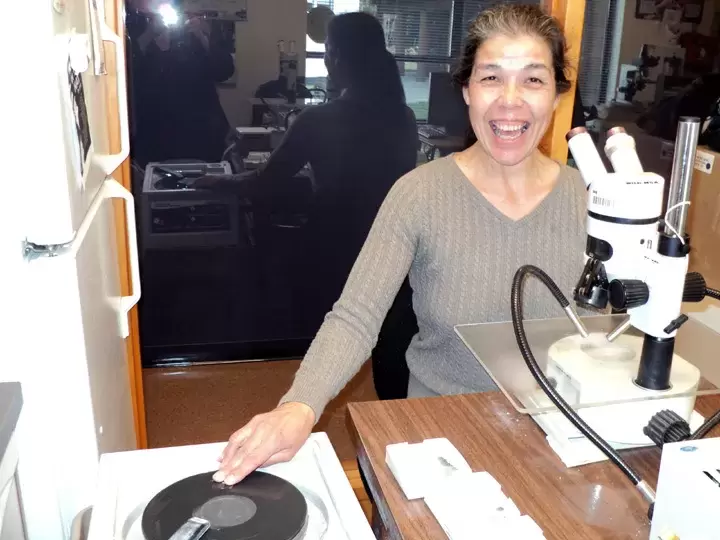Judy Joseph of Ditidaht and Susan Cootes of Uchucklesaht have worked for more than a decade helping to answer some of science’s most perplexing questions about salmonids.
In their lab at the Hupacasath Band office in Port Alberni, Judy and Susan have dissected many thousands of fish heads over the years to analyze otoliths ("earstones") as part of the otolith marking program.
The skill and dedication shown by Judy and Susan have earned them wide respect and their work has contributed to the effort to shape fisheries and protect natural salmon stock.
Judy and Susan have worked diligently to advance the understanding of what makes each of our salmon special.
Judy, however, is set now to retire, and the local Otolith lab will be looking for people who might be interested in doing this seasonal work.
Judy was once a commercial fisher until the displaced fisher program was implemented, introducing her to her first fisheries work more than 16 years ago.
She started as a creel surveyor in Port Alberni, working at China Creek and Clutesi Marina collecting catch and biosample data from local sport fishermen.
She then trained as an Otolith lab technician to dissect and prepare salmon otolith samples and read their thermal mark.
Before hatchery-raised salmon fry are released into the wild, hatchery personnel mark the otolith of the fry through manipulation of water temperature. Each hatchery on the West Coast has a specific temperature pattern at which its mark will appear on the otoliths .
When a commercial or recreational fisherman catches a salmon, the head of the fish, if sampled, is sent to the Department of Fisheries and Oceans for analysis and identification. (Sometimes a hatchery fish is identified by the clipped adipose fin but often not.)
Judy and Susan have learned a lot from these fish heads, such as information about salmon migration and spawning behavior.
For example, they have learned that Chinook, which originate from West Coast Vancouver Island rivers, like to hug rocks and shoreline while making their way back home to spawn. One would rarely find these Chinook more than one mile offshore.
Fish sampling can detect where hatchery fish are interacting with wild fish. It can also answer the question of what portion of the spawners are hatchery fish versus natural.
Judy and Susan carve out an otolith from the fish head, mount it on a glass slide and then grind it down into a paper-thin cross-section that can be studied through a powerful microscope.
In an article by David Wiwchar published in 2002 in a newspaper called Raven’s Eye, the process is explained:
The layers or rings of the bone are much like the rings of a tree, telling scientists how old the fish is and whether it enjoyed bountiful years or lean years with little food. The cross-section also contains the thermal mark, allowing Judy and Susan to determine which hatchery raised and released the fish.
“The information we gather here is used to study fish movements up and down the coast, and also to explore issues around hatchery and wild fish,” said Susan.
“The data we collect here is combined with all kinds of other data, like creel surveys, ocean productivity and temperature patterns and stomach content studies to gain a better understanding of how hatchery salmon interact with and compete with wild salmon,” she said.
Susan began her fisheries experience at the San Mateo Bay Fish Farm. She then went on to the Henderson Lake Hatchery where she worked the rotary trap, counting and sampling juveniles.
Summers were spent sounding Henderson Lake and Kildonan Harbour in a herring skiff for DFO studies.
Opportunity then led to a DFO creel surveying job at Clutesi Marina where she worked with Judy. Later she would work alongside Judy again in the otolith laboratory, dissecting, processing and analyzing both adult and juvenile Chinook, coho, and sockeye otoliths, looking for hatchery induced thermal marks.
The information gathered in the sampling is put into a database and the results flow to the North Pacific Anadromous Fisheries Commission which helps coordinate otolith marking and assessment throughout the North Pacific.
The otolith marking program has been operating in Canada for the past 20 years, and in the United States for about 30 years.
Everyone involved with the lab thanks Judy for her hard work and dedication over these past years and wish her all the best in her retirement. There is a plan to hire two trainees this fall, with one position continuing into the New Year.
If you would like to learn about and work with otoliths, please send your resume to the Hupacasath Band office, attention Susan Cootes, Otolith Lab.
Story with files from Vol. 6 Issue 2, Raven’s Eye, 2002 article by David Wiwchar entitled “Nuu-chah-nulth women study salmon mysteries” as found on www.ammsa.com







